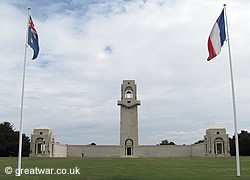1st Australian Division Memorial, Pozières
The memorial commemorates the officers, non-commissioned officers and men of the First Australian Division who fought in France and Belgium in 1916, 1917 and 1918. The commemorative tablet on the memorial lists the battle honours for the 1st Australian Division:
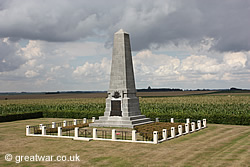
|
POZIERES — MOUQUET FARM — LE BARQUE — THILLOY — BOURSIES — DEMICOURT — HERMIES — LAGNICOURT — BULLECOURT — 3RD BATTLE OF YPRES — MENIN ROAD — BROODSEINDE RIDGE — PASSCHENDAELE — BATTLE OF THE LYS — 2ND BATTLE OF THE SOMME — LIHONS — CHUIGNOLLES — HINDENBURG LINE
The memorial site was developed to maintain its preservation as a feature on the battlefield of the Somme, 1916 by le Conseil Général de la Somme.
Battle of Pozières Ridge (23rd July - 7th August 1916)
The village of Pozières is located on the ridge of high ground on the main road between Albert and Bapaume. Poziers was one of several villages incorporated into the German Second Position on their Somme battlefront. The Pozières sector consisted of bunkers, strongpoints and machine gun posts. It was the highest place on the Somme 1916 battlefield and as such was a vital objective for the Allies to try to take from the German Army. Whichever side held this high ground had a magnificent view of the surrounding countryside. The capture of Pozières had been one of the objectives of the British offensive launched on 1st July 1916. However, the stubborn German defence and high Allied casualties on that day had meant that this high ground and Pozières were not reached and captured at that time.
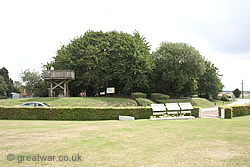
|
The 1st ANZAC Corps, consisting of the 1st, 2nd and 3rd Australian Divisions, arrived in the area behind the British front on the Somme battlefield from 14th - 18th July, travelling here from the battle front at Armentières in French Flanders. Following on after four attacks made on the village by the British Fourth Army, with little success and high casualty numbers, the 1st Australian Division, commanded by Major General Harold Walker, launched into the attack on Pozières at 12.30am in the early hours of 23rd July. They were part of an attack launched by the British Reserve Army under the command of Lieutenant General Hubert Gough. The Australian Division attacked Pozières village from the south, with the British 48th (Midland) Division attacking the village from the west on their left. At this time the Pozières Front Line area was held by the German 117th Division.
After a very hard fight the 1st Australian Division captured Pozières village by the end of 23rd July 1916. For the next four days the division held its ground in the face of a constant artillery bombardment focused on the village from the German guns. The German bombardment continued in its intensity reaching a peak on 26th July. The remnants of the division were relieved by 2nd Australian Division on 27th July.
The casualties of 1st Division numbered almost 5,300 in those few days. The survivors were said to be dazed and haggard when they were relieved from the village.
Victoria Cross Winners
Private John Leak, VC
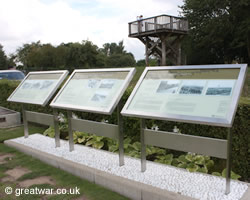
|
No. 2053 Private John Leak, of the 9th Battalion, Australian Infantry, was awarded the Victoria Cross for his bravery at Pozières:
“For most conspicuous bravery. He was one of a party which finally captured an enemy strong point. At one assault, when the enemy's bombs were outranging ours, Private Leak jumped out of the trench, ran forward under heavy machine-gun fire at close range, and threw three bombs into the enemy's bombing post. He then jumped into the post and bayonetted three unwounded enemy bombers.
Later, when the enemy in overwhelming numbers was driving his party back, he was always the last to withdraw at each stage, and keep on throwing bombs.
His courage and energy had such an effect on the enemy that, on the arrival of reinforcements, the whole trench was recaptured.” (1)
John Leak was born in Portsmouth, Hampshire, England. He survived the war and lived to be 76 years old, passing away in Adelaide, South Australia, in October 1972.
Lieutenant Arthur Seaforth Blackburn, VC, CMG, CBE, ED
Serving as a Second Lieutenant with the 10th Battalion, Australian Infantry, Arthur Blackburn was awarded a Victoria Cross for his gallantry at Pozières:
“For most conspicuous bravery. He was directed with fifty men to drive the enemy from a strong point. By dogged determination he eventually captured their trench after personally leading four separate parties of bombers against it, many of whom became casualties.
In face of fierce opposition he captured 250 yards of trench. Then, after crawling foward with a Serjeant to reconnoitre, he returned, attacked and seized another 120 yards of trench, establishing communication with the battalion on his left.” (2)
Lieutenant Blackburn was born in 1892 in Adelaide, South Australia. He survived the Great War and passed away aged 67 in Adelaide.
Viewing Platform
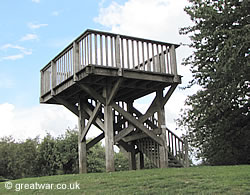
|
A viewing platform has been constructed to enable visitors to have a magnificent view across the Somme battlefields.
Information panels explain about the site to visitors and the part played by 1st Australian Division in the battle here.
“Gibraltar” German Blockhouse Remains
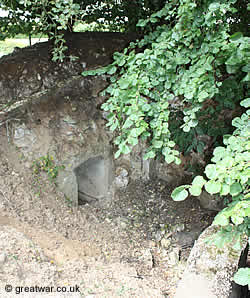
|
One of the German bunkers in this location has been partially preserved (no access — preserved for viewing only).
There was a very large strongpoint in the western end of Pozières village, named “Panzerturm” by the Germans. One level was built 3 metres above ground with two floors also built below ground. Owing to it's prominence in the rubble of what was left of the village, the Australians called the strongpoint “Gibraltar”, presumably in likeness of the rock of Gibraltar as it protrudes from the Mediterranean. Some remains of this bunker can be seen at the memorial site.
Dr Ross J Bastiaan Memorial Plaque
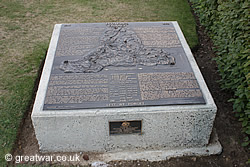
|
Dr Ross Bastiaan is practising periodontist in Melbourne, Victoria, and a Colonel in the Australian Army Reserve. Since 1990 Dr Bastiaan has been responsible for placing over 140 bronze relief plaques at the sites of action of Australian Forces around the world.
One of the bronze memorial plaques is situated at this memorial site. The plaque is made up of a bronze relief map of the 1916 and 1918 Somme battlefields. In English and French there is an overview of the part played by the Australian Forces at this place it gives casualty figures for the Allies and Central Powers, it notes the Australian Memorials in France.
Location of 1st Australian Division Memorial
The memorial is located on the north side of the D929 Albert-Bapaume road, on a signposted side road off the main road, in the south-west part of the village of Pozières.
Parking
There is a designated area for parking close to the memorial.
Related Reading

Pozières: The Anzac Story [Paperback]
by Scott Bennett
Published by Scribe Publications (June 2011). 398 pages. ISBN-10: 1921640359, ISBN-13: 978-1921640353

Pozières: Somme (Battleground Europe Series) [Paperback]
by Graham Keech
Published by Pen & Sword Books Ltd. (Sep 1997). 160 pages. ISBN-10: 0850525896, ISBN-13: 978-0850525892

Over the Top: A Digger's Story of the Western Front
by H G Hartnett
Henry George Hartnett enlisted in the Australian Imperial Force in September 1915. He saw action at the Battle of Fromelles and the Battle of the Somme 1916, where he was badly wounded. On his recovery he rejoined his battalion on the Western Front. This is a highly recommended book. 348 pages. Published by Allen & Unwin (1 Nov 2012), ISBN-10: 9781742375953; ISBN-13: 978-1742375953
Related Topics
Australian Memorial, Pozières Windmill
Australian Memorial, Pozières Windmill
Villers-Bretonneux Australian National Memorial
Villers-Bretonneux Australian National Memorial
Franco-Australian Museum, Villers-Bretonneux
Franco-Australian Museum, Villers-Bretonneux
Related Link
The ANZAC Portal
Australian visitors may be interested to see a website established by the Australian Government which provides information about the major sites to visit in France and Belgium where the Australian forces fought and where they are commemorated.
Website: anzacportal.dva.gov.au
Acknowledgements
(1) Supplement to the London Gazette, 9 September 1916, page 8871. Supplement to the London Gazette Issue 29740 published on 8 September 1916.
(2) Supplement to the London Gazette, 9 September 1916, page 8870. Supplement to the London Gazette Issue 29740 published on 8 September 1916.

